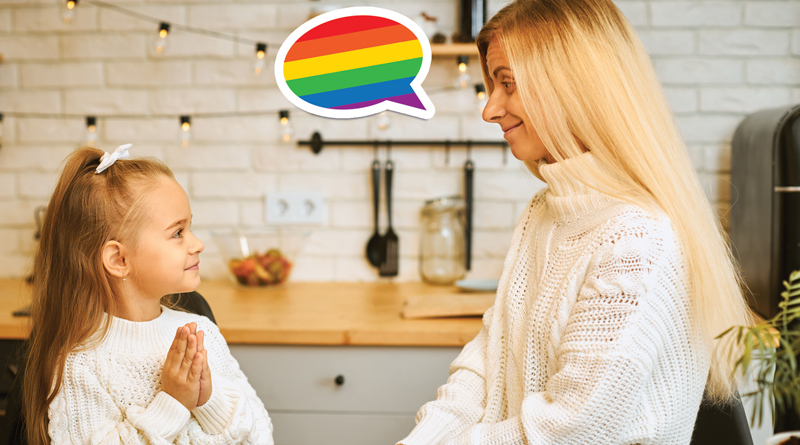Resources to Educate Families about Gender Identity
By: Maria Alejandra Pulgar
Over the years, the evolution of communities has created opportunities for more families with non-traditional structures to integrate into the dynamics of society. Those family models are not new, they have always existed; the difference now is that more recognition, education, and the granting of civil rights allow them to live openly and freely.
The lack of previous exposure to non-traditional family models spark in children curiosity and questions for parents that often they are not sure how to answer. The best approach is education, awareness, and anticipation. Parents who desire to raise empathic, respectful, and informed children in this modern society, need to educate themselves to be ready to discuss with them the matters that they are likely to find in the community, the media, and even at school.
Previous generations were not exposed to many situations children nowadays face. Uniparental families, same-sex parent families, children and adults in the community with non-traditional gender identities or orientations, etc., are social interactions that children observe, and it is their parent’s responsibility to provide them with knowledgeable information, along with ethical, religious, tradition or value context that they consider important that their children manage.
We provide below an array of resources to help you learn about gender identity and sexual orientation, and how to talk to your children at different ages and stages, whether they ask you about it or you decide to bring out the conversation.
When and where do we start?
Generation X parents and those older than them, who were raised in more conservative environments and times, find difficult to have conversations with their children about private issues. Millennial parents and younger, on the other hand, address conversations about difficult matters with their children using more open approaches, as in their majority their upbringing received more exposure to broader information and diverse points of view.
The moment to talk about gender identity depends on the age of the child. According to the American Academy of Pediatrics (AAP) children “become conscious of the physical differences between boys and girls” around two years old, and by age four they have “a stable sense of their gender identity”, it means, labeling themselves as a boy or girl. However, young children play with “cross-gender roles and behaviors” as a normal part of their exploration and development.
An AAP report explains that “assigned gender” or “sex” is based on the physical characteristics of the person at birth, whereas “gender identity refers to an internal sense people have of who they are that comes from an interaction of biological traits, developmental influences, and environmental conditions. This may be male, female, somewhere in between, a combination of both or neither.”
Other related definitions are: “gender expression, the external way a person expresses their gender, such as with clothing, hair, mannerisms, activities, or social roles”; and “gender perception” which is the way others interpret how a person presents their gender.
As the self-identification with a specific gender occurs around four years old, AAP research has found that “all children tend to develop early a clearer view of themselves and their gender” and that those children who express a gender-diverse identity “know their gender as clearly and consistently as their peers and benefit from the same level of support, love and social acceptance.”
When facing the situation of a gender diverse child at home, parents need to address all mental, physical and social challenges related to it in the most positive, constructive, and healthy way for the wellbeing of the child. Each child is different and each approach and outcome will be different. The important part is facing it with love and in the best interest of the child with the help of an expert.
The AAP has compiled on their Healthy Children website detailed information and support resources to assist families on this process
The YES Institute in Miami-Dade also offers information and support on gender orientation for youth and families www.yesinstitute.org
Build trust to talk to your children
Children before age three need to learn to name all their parts of their body with the correct names; that include their private parts. It creates the foundation for a healthy relationship with their own bodies and also the trust with their parents or caregivers to continue asking questions regarding sex and development in the future.
As children grow and become more exposed to the community, parents need to keep asserting the facts about sex, gender expression, and gender perception with them, using age appropriate materials that help keep communication open to reinforce concepts and listen to their questions or doubts on the matter.
For more specific communication techniques by age group visit https://www.todaysparent.com/family/parenting/how-to-talk-to-kids-about-gender-age-by-age-guide/
Other Support and training resources
Empathy and Respect are learned by example. Communities educated and informed about gender diversity grow to be more welcoming and supportive for families, children and individuals with gender differences.
For more educational resources you can visit:
Tools for understanding gender complexities: https://hues.xyz/genderbread-person
American Psychological Association – Gender Exploration: https://www.apa.org/ed/schools/primer/gender-identity
Spiritual Support for families: https://couragerc.org/for-families/
Outreach to LGBTQ community: www.outreach.faith
Family Acceptance Project: https://familyproject.sfsu.edu/


Tough topic to write on given the politics behind this subject, but thank you for putting together and providing resources for those parent who want to be prepared or proactive in the discussion.